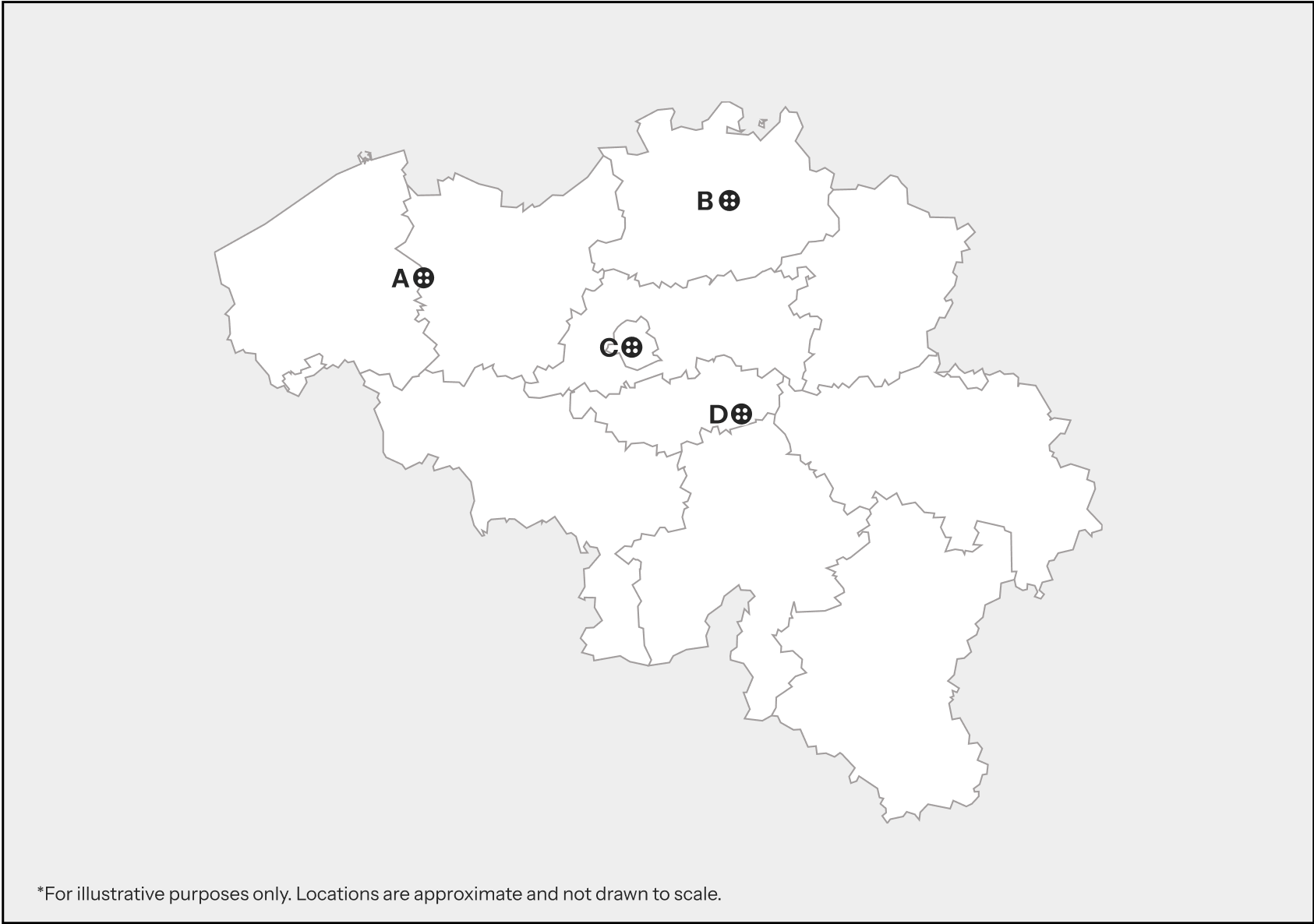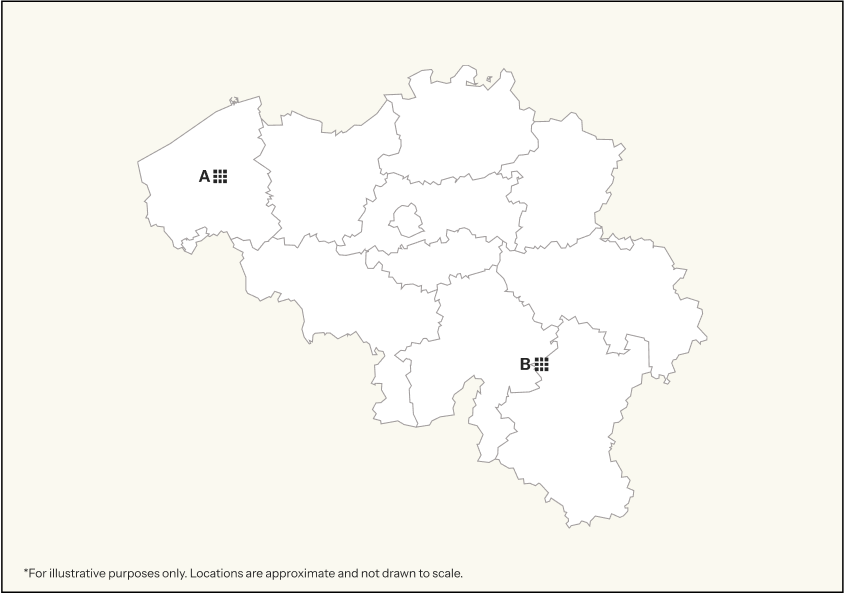Belgium
download summary
Country Overview
No items found.
*All data is in tonnes per annum
TEXTILE WASTE*
2,116,000
Post consumer textile waste
1,036,840
Cotton
42.17%
Polyester
10.70%
Poly cotton
12.46%
Acrylic
4.79%
Viscose
4.31%
Wool
1.76%
Polyamide
1.28%
Other blends
19.33%
Other pure materials
0.80%
Unknown
2.40%
pre consumer textile waste
Post Industrial textile waste
Cotton
Polyester
Poly cotton
Acrylic
Viscose
Wool
Polyamide
Other blends
Other pure materials
Unknown
Imported textile waste
Cotton
Polyester
Poly cotton
Acrylic
Viscose
Wool
Polyamide
Other blends
Other pure materials
Unknown
*This data is collectively from Belgium, Germany, UK, Netherlands, Poland & Spain
KEY POINTS ON Textiles & Apparels LANDSCAPE
2%
Contribution of Manufacturing GDP
Belgium’s textile industry remains relatively small. The sector is highly export-oriented, with technical textiles making up the largest share of production. In 2023, exports to key European markets such as France, Germany, and the Netherlands declined, while Italy showed some growth. Despite lower production capacity utilization and contracting employment, the industry continued to invest in sustainability and digitalization
€69.3M
Cotton Imports (2024-25)
€513M
Flax Fibre Export (2025)
Belgium sources most of its textile raw materials such as cotton, wool, and synthetics through imports, while its domestic fiber agriculture is centered on high-quality flax grown mainly in Flanders.
95%
Industries are SME's
Belgium’s textile and apparel industry is dominated by SMEs and is highly export-oriented, with 80% of output sold within the EU. It holds a leading global position in high-end home textiles, especially carpets, with home textiles making up 40% and industrial textiles 20% of output. Backed by a strong textile machinery sector, the industry focuses on high-value, specialized products
50%
Separate Capture Rate
Belgium generates about 15.5 kg of textile waste per capita and has the largest share of separate textile collection in Europe, supported by multiple collection systems. However, with sorting dominated by manual processes, around 75% of sorted post-consumer textiles are exported mainly to Africa for reuse and Asia for recycling or landfill. Domestic recycling capacity remains very limited.
waste cost
waste Type
composition
price
notes
Post-Consumer
Cotton / Wool / Acrylic
€0.02–0.14 / kg
Feedstock for fibre-to-fibre recycling
It has a planned and existing sorting capacity of 81,700 tonnes and a recycling capacity of 1502 tonnes, hence it can leverage investments in the recycling technology within the country ( 2023 )
production clusters
Key regions with apparel production:
Flanders(A), Antwerp(B), Brussels(C), and Wallonia(D)

- Belgian retailers receive VAT relief on garments donated to local charities (this does not apply to exports).
- Major players in apparel manufacturing include - De Paepe N.V., Avetex N.V., Gelitex B.V.B.A. and fibre producers like Balta Group, Brutex, Concordia Textiles, Alsico
Waste regulation
It is a comprehensive plan aiming to transform how textiles are designed, produced, consumed, and disposed of across the EU. It includes measures to make textiles durable, repairable, recyclable, and largely made of recycled fibers, while addressing overproduction, microplastic release, and greenwashing. The strategy sets the goal to achieve a sustainable and circular textile sector by 2030, aligned with the European Green Deal and Circular Economy Action Plan.
Strengthens waste management by mandating all EU member states to separately collect textile waste from January 1, 2025 and imposing Extended Producer Responsibility (EPR) schemes requiring producers to finance and organize the entire lifecycle management of their products’ waste. It emphasizes the waste hierarchy prioritizing prevention, preparing for reuse, recycling, recovery, and environmentally sound disposal, with clear definitions on when waste ceases to be waste (end-of-waste criteria)
Effective May 20, 2024, it tightens controls on waste shipments, including textiles, within and outside the EU. It bans most waste exports for disposal after May 21, 2026, requires audits, digital tracking, and enforces stricter penalties. The law supports the circular economy by ensuring environmentally safe waste management.
Effective July 18, 2024, it mandates durability, repairability, recyclability, and increased recycled content for textiles and most products. It requires Digital Product Passports, bans destruction of unsold textiles by large companies, and enforces life cycle environmental impact reduction. The regulation enables product-specific rules and harmonized penalties, driving a circular economy and sustainable production.
Waste trade
148.21 kT
Import quantities (HS 6309, 631010)
204.81 kT
Export quantities (HS 6309, 631010)
green energy
11.68%
Share of modern renewables in final energy consumption
- Renewable Electricity Generation by source: wind (62%), solar (31.4%) & hydro (6.6 %)
- Flemish "Moonshot" program: It provides €20 million annually from 2020 to 2040, to support industrial innovation focused on developing breakthrough climate-friendly technologies for a carbon-neutral and circular economy. It aims to accelerate the transformation of Flemish industry towards climate neutrality by 2050.
- National Recovery and Resilience Plan NRRP: Dedicates approximately €2.7 billion to measures supporting the green transition, including energy-efficient renovations of buildings, sustainable mobility, climate innovation, and renewable energy projects


